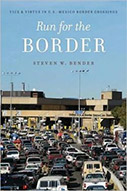Run for the Border: Vice and Virtue in U.S.-Mexico
Border Crossings (Citizenship and Migration in the Americas)

Author: Steven W. Bender
Publisher: New York: New York University Press, 2012. 224p.
Reviewer: David Hatten | July 2013
Upwards of 60,000 people in Mexico have died in the last eight years due to an escalating conflict between illegal drug traffickers and U.S. authorities. This conflict is largely attributed to U.S. domestic and foreign policies supporting the “War on Drugs” that have increased the militarization of the border between the two countries. The framework currently used to fight the “War on Drugs” attacks the issue of illegal drug trafficking from the supply side perspective, and enforces the law through interdiction, while also calling for increased criminalization on the production, trafficking, and use of drugs. This has pushed both nations closer to being police states.
Drugs, however, are not the sole issue in this complex transnational conflict. Since 1994, Mexico has been reeling from an economic crisis that has the country experiencing high unemployment rates, as well as IMF structural adjustment policies that have left Mexicans subject to foreign aid and food imports. But the tide is shifting, and the “War on Drugs” is coming under increasing attack.
Stephen Bender in Run for the Border: Vice and Virtue in U.S. Mexico Border Crossings takes aim at the failed war on drugs to promote adoption of more comprehensive and humanized policies. The book, comprised of five parts and fourteen chapters, provides a look at life on both sides of the U.S. Mexico border. Open immigration is a central piece of the comprehensive policy that is proposed in Run for the Border. Bender posits that if the needs of U.S. labor markets are so great, then why not open the borders and let Mexican laborers fill this need in a regulated way? The common argument against immigration, that Mexican laborers are stealing “American” jobs, he suggests could be dealt with by extra taxes to be imposed on hiring foreign laborers.
According to Bender, “the U.S. labor markets must accept that the quid pro quo for a ready supply of Mexican immigrant labor in the good times is to offer Mexican laborers their rightful place to receive the safety net of government assistance during the downturns” (159). Extending citizenship rights and benefits to illegal immigrants working in the U.S. is a contested issue, especially during one of the worst recessions in the country’s history, and this policy would likely only be accepted by a very progressive audience. To counter the idea that Mexican immigrants constitute a drain on the public purse, Bender shows the link between economics and immigration, as he highlights the illegal border crossings falling with the recession in 2008, concluding that, “the migration slowdown during the recession confirms that the only effective border strategy is not walls or armed vigilantes, or employer sanctions and workplace raids, but economic strategies” (136). While this is a useful piece of evidence to support a regulated and stable labor force through open immigration, Bender’s argument lacks scholarly depth.
Bender is at his best in both the second and fourth parts of his analysis while dissecting the economic motives for border crossings. In both countries he confidently covers the complex forces at work with the shifting of markets and the laborers who work in them. Bender’s only support of current policy is the attempted, yet currently stalled, restructuring of NAFTA by President Obama. NAFTA has liberalized trade throughout the United States and virtually removed the import tariffs that once protected domestic Mexican industries. According to Bender, “much of the U.S. economic presence and influence in Mexico is deeply flawed … free trade disrupts rural regions, sending residents fleeing to the borderlands in search of survival” (175). Although the NAFTA agreement was not a unilateral policy initiative, the results have favored the United States and Canada at the expense of Mexico. Bender suggests that a fundamental restructuring of NAFTA will be necessary to achieve long term peace on the border.
In the chapter called “Reefer Madness,” Bender draws on the increasingly popular concept of harm reduction to suggest a framework for addressing the widespread drug trade and subsequent violence throughout the Americas. As part of this he calls for a demand-side approach described as legalization with a public health focus that “means that [the] government can concentrate on funding studies and technology to curb addiction rather than striving to entrap smugglers, dealers, and users” (168).
Harm reduction, which might be difficult to implement in the U.S, has been adopted to differing degrees in Europe and is being debated throughout Latin America as one way to reduce violence. Bender proposes that, “a return to the days of Mexican government corruption that for decades tolerated the drug trade (for a healthy cut, of course) as long as the traffickers acted more like businessmen than thugs is a better choice for Mexico than the continued chaos and bloodshed” (170).
Bender argues that harm reduction will curb demand for drugs in the U.S. in the long term and that, with time, would lessen the conflict between the cartels and the government. The legalization of marijuana and small quantities of other drugs is predicted to parallel the ending of prohibition of alcohol in the U.S., allowing law enforcement to focus on the still thriving methamphetamine, heroin, and cocaine trade.
At times the book reads in somewhat scatter shot fashion, jumping from one aspect of the border to another with much overlap and little fluidity. The historical analysis that begins the book covers racially motivated drug laws and enforcement, and fugitives of justice, but is merely filler. However, the second half of the book has redeeming qualities given the sense of hope that it instills in the reader. If there is one insight that is clearly articulated throughout this work it is that the decisions that our governments make, whether unilaterally or cooperatively, have a direct and critically important impact on their constituents.
David Hatten, Graduate Student, Geography and Urban Studies, Temple University


